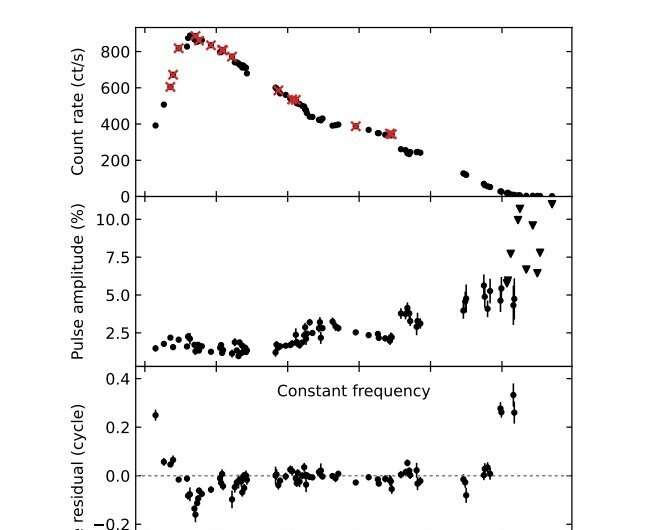August 18, 2022 report
Astronomers discover new accreting millisecond X-ray pulsar

Using the Neutron Star Interior Composition Explorer (NICER), an international team of astronomers have detected a new accreting millisecond X-ray pulsar. The newfound pulsar, designated MAXI J1816–195, has a spin period of about 1.89 milliseconds. The finding is reported in a paper published August 9 on the arXiv pre-print repository.
X-ray pulsars exhibit strict periodic variations in X-ray intensity, which can be as short as a fraction of a second. Accreting millisecond X-ray pulsars (AMXPs) are a peculiar type of X-ray pulsars in which short spin periods are caused by long-lasting mass transfer from a low-mass companion star through an accretion disk onto a slow-rotating neutron star. Astronomers perceive AMXPs as astrophysical laboratories that could be crucial in advancing our knowledge about thermonuclear burst processes.
AMXPs are relatively rare and to date only a few dozen objects of this type have been identified. In order to expand the list of these peculiar objects, the scientific community is still actively searching for such sources using space observatories like NICER installed on the International Space Station (ISS).
Now a group of astronomers led by Peter Bult of University of Maryland, reports the finding of a new AMXP with NICER. They found that a recently discovered X-ray transient, named MAXI J1816–195 exhibits 528.6 Hz pulsations. MAXI J1816–195 was first identified on June 7, 2022 by the Monitor of All-sky X-ray Image (MAXI) onboard the ISS. Follow-up observations of this source with NICER confirmed its AMXP nature.
"We present the discovery of 528.6 Hz pulsations in the new X-ray transient MAXI J1816–195. Using NICER, we observed the first recorded transient outburst from the neutron star low-mass X-ray binary MAXI J1816–195 over a period of 28 days," the researchers wrote in the paper.
According to the study, MAXI J1816–195 has a spin period of 1.89 milliseconds and orbital period of about 4.8 hours. The mass of the donor star was estimated to be between 0.1 and 0.55 solar masses. Based on the results the upper limit of the distance to this pulsar was found to be 28,000 light years.
The observations identified 15 thermonuclear X-ray bursts from MAXI J1816–195 exhibiting a gradual evolution in morphology over time. The average recurrence time of these bursts was measured to be approximately 1.4 hours. It turned out that MAXI J1816–195 is a regular burster with a recurrence time that lengthens over the course of the outburst.
Furthermore, the study found that all observed X-ray bursts showed a very similar evolution, both in light curve and in their spectroscopy. The burst durations point to ignition in a hydrogen rich environment, which suggests that the accreted material and thus the donor star must be hydrogen rich. The researchers added that no evidence for burst oscillations were found in the collected data.
More information: The discovery of the 528.6 Hz accreting millisecond X-ray pulsar MAXI J1816-195, arXiv:2208.04721 [astro-ph.HE] arxiv.org/abs/2208.04721
© 2022 Science X Network




















